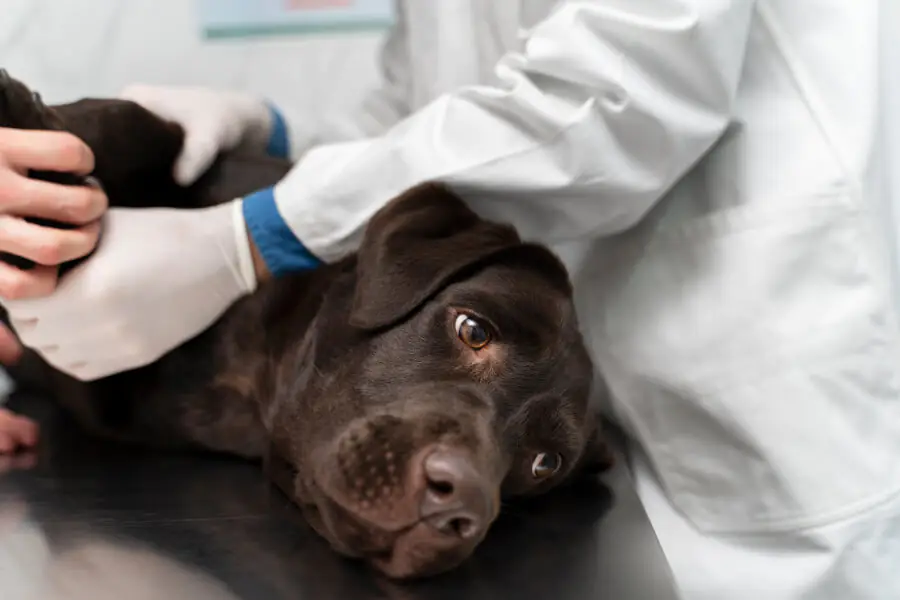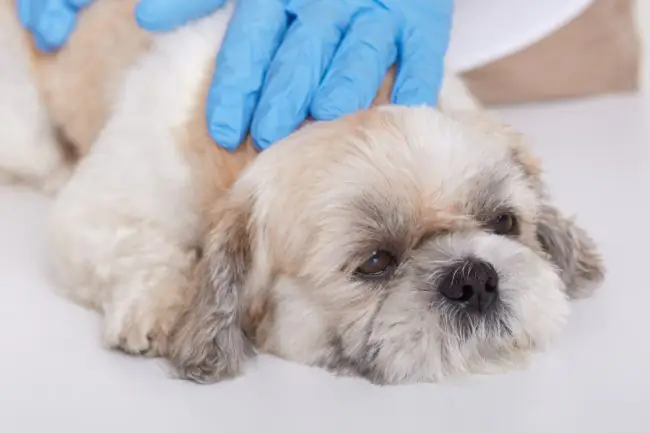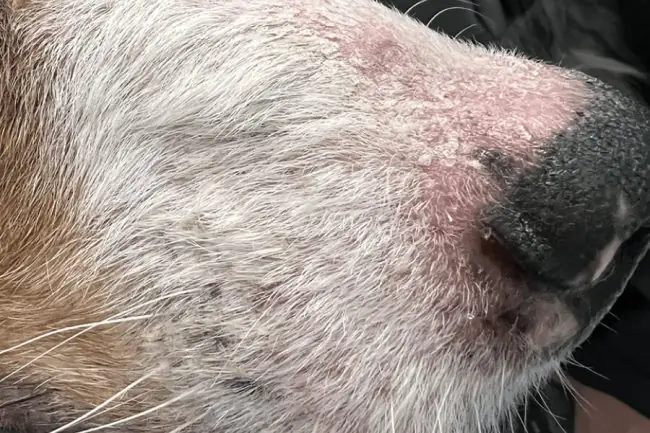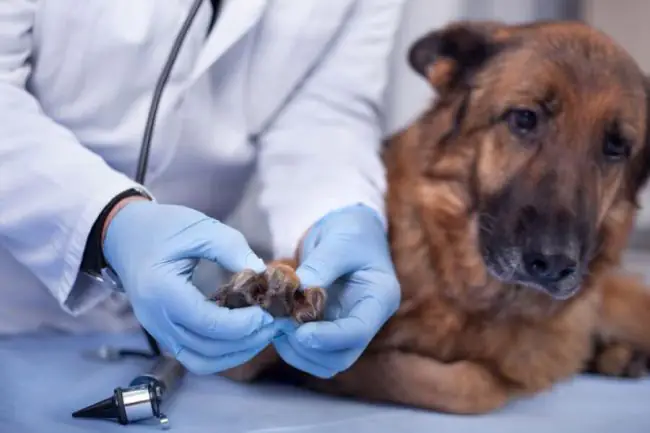As a responsible dog owner, understanding the common dog diseases that affect your pet and how to prevent them is key to keeping your furry friend happy and healthy from viral infections like parvovirus to preventable illnesses like Leishmaniasis.
Knowing the five most common dog diseases, signs, symptoms, and preventive measures can help you protect your dog from severe health risks while sharing practical tips on how to keep your pet safe.
Canine Parvovirus
Canine parvovirus is a highly contagious viral dog disease that primarily affects puppies and unvaccinated dogs. It attacks the gastrointestinal system, causing severe vomiting and diarrhea, which can lead to dehydration.
Symptoms of Canine Parvovirus
- Vomiting
- Diarrhea (often bloody)
- Lethargy
- Loss of appetite
- Fever
Prevention of Canine Parvovirus
Prevention starts with early vaccination. Make sure your dog receives the full set of parvovirus vaccines, particularly when they are puppies. Additionally, maintain proper hygiene by cleaning your dog’s living area, as the virus can live in the environment for months.
Leishmaniasis in Dogs
Leishmaniasis is a parasitic dog disease caused by protozoa of the genus Leishmania. This kind of dog disease is primarily transmitted through the bite of infected sandflies. This dog disease is endemic in many parts of the world, including the Mediterranean region, parts of Latin America, and the Middle East. In Spain, Leishmaniasis is a significant concern, especially in the warmer months when sandflies are more active.
This dog disease can manifest in various forms, including cutaneous (affecting the skin) and visceral (affecting internal organs). The visceral form is more severe and can be life-threatening if not treated promptly.
Symptoms
Cutaneous Leishmaniasis:
- Skin lesions such as ulcers or nodules, typically around the eyes, ears, and muzzle.
- Hair loss and skin thickening.
- Itching and discomfort.
Visceral Leishmaniasis:
- Fever and weight loss.
- Enlarged lymph nodes and spleen.
- Abdominal pain and vomiting.
- Anemia and lethargy.
- Reduced appetite.
Prevention
Avoid Sandfly Exposure:
- Keep dogs indoors during peak sandfly activity, which is typically dusk and dawn.
- Use sandfly repellents specifically formulated for dogs.
- Install screens on windows and doors to prevent sandflies from entering the home.
Vaccination:
- There is a vaccine available in Spain that can help protect dogs from Leishmaniasis. Consult with your veterinarian about the best vaccination schedule for your pet.
Regular Veterinary Check-ups:
- Schedule regular check-ups with your veterinarian to monitor your dog’s health and check for any signs of Leishmaniasis.
Use of Collars:
- Sandfly-repellent collars can provide additional protection.
Heartworm Dog Disease
Information on Heartworm Dog Disease
Heartworm dog disease is caused by parasitic worms that live in the heart, lungs, and blood vessels of infected dogs. Mosquitoes transmit heartworm larvae, which grow and can cause significant damage to a dog’s organs if left untreated.
Signs and Symptoms of Heartworm Dog Disease
- Persistent cough
- Fatigue after mild activity
- Weight loss
- Difficulty breathing
- Swollen abdomen due to fluid buildup
Preventing Heartworm Dog Disease
Heartworm prevention is crucial, especially in warmer regions of Spain where mosquitoes are common. Preventive medication, given monthly, is an effective way to protect your dog from this life-threatening dog disease. Regular check-ups and blood tests can help catch early signs of infection.
Anaplasmosis Dog Disease
Anaplasmosis is a tick-borne dog disease caused by bacteria of the genus Anaplasma. This kind of dog diseases like this is primarily transmitted through the bite of infected ticks, particularly the Ixodes and Rhipicephalus species. It is prevalent in various parts of the world, including Europe, the United States, and parts of Asia. In Spain, Anaplasmosis is a concern, especially in rural areas where ticks are common.
There are two main forms of Anaplasmosis in dogs: Anaplasma phagocytophilum (causing granulocytic anaplasmosis) and Anaplasma platys (causing thrombocytic anaplasmosis).
Symptoms
Granulocytic Anaplasmosis (Anaplasma phagocytophilum):
- Fever and lethargy.
- Loss of appetite.
- Joint pain and stiffness.
- Vomiting and diarrhea.
- Enlarged lymph nodes.
Thrombocytic Anaplasmosis (Anaplasma platys):
- Bleeding disorders, such as nosebleeds or bruising.
- Lethargy and weakness.
- Decreased platelet count leads to an increased risk of bleeding.
Prevention
Tick Prevention:
- Use tick prevention products, such as topical treatments, oral medications, or tick collars, recommended by your veterinarian.
- Regularly check your dog for ticks, especially after outdoor activities in tick-prone areas.
Maintain a Clean Environment:
- Keep your yard and living areas clean and free from tall grasses and underbrush where ticks may reside.
Regular Veterinary Check-ups:
- Schedule regular veterinary visits to monitor your dog’s health and discuss appropriate tick-prevention strategies.
Prompt Tick Removal:
- If you find a tick on your dog, remove it promptly using tick removal tools. Ensure that the tick is removed completely to prevent infection.
Leptospirosis
Understanding Leptospirosis Dog Disease
Leptospirosis is a bacterial disease that affects both humans and dogs. It is spread through contaminated water, soil, or the urine of infected animals. Dogs can contract the bacteria while swimming or drinking from infected water sources.
Symptoms of Leptospirosis
- Fever
- Vomiting
- Muscle pain
- Jaundice (yellowing of the eyes or skin)
- Kidney or liver failure in severe cases
Preventive Measures for Leptospirosis
Vaccination is the best way to protect your dog from leptospirosis. Additionally, avoid letting your dog swim in stagnant water or drink from unknown sources. Keep their environment clean, and schedule regular vet check-ups to monitor their health.
Emerging Dog Diseases in the Spanish Dog Population
Ehrlichiosis: An Emerging Concern
Ehrlichiosis is another tick-borne illness that affects dogs. It can cause symptoms such as fever, bleeding disorders, and weight loss. Regular tick prevention and prompt veterinary care are important.
New Challenges in Canine Health
As the climate and environmental conditions change, new of dog diseases and health challenges for dogs may arise. Staying informed and proactive is essential for maintaining your dog’s health.
Protecting Your Pet: Best Practices for Dog Owners
Regular Veterinary Check-ups and Monitoring
Routine vet visits are vital for early detection of dog diseases and overall health maintenance. Regular check-ups help ensure that your dog receives the necessary vaccinations and preventative treatments.
Nutritional Guidelines for Optimal Health
A balanced diet tailored to your dog’s age, size, and activity level supports their overall health and immune system. Consult your vet for dietary recommendations.
Environmental Factors Affecting Dog Health in Spain
- Climate: Be mindful of how hot or cold weather affects your dog.
- Exposure to Wildlife: Avoid letting your dog roam in areas with high tick populations.
Vaccinations for Dogs in Spain
Vaccinations are the cornerstone of preventative health care for dogs. They protect against various dog diseases, some of which can be severe or even fatal. Regular vaccinations help prevent the spread of dog diseases and keep your dog healthy.
Common Vaccines Recommended for Dogs in Spain
- Canine Parvovirus: Essential for all puppies and adult dogs.
- Distemper: Protects against a potentially deadly virus.
- Hepatitis: Prevents canine infectious hepatitis.
- Leptospirosis: Important in areas where the dog disease is prevalent.
- Rabies: Mandatory vaccination in Spain for legal and health reasons.
The Risks of Ticks and Fleas for Dogs
Ticks and fleas are more than just a nuisance; they can transmit serious dog diseases like Lyme disease and tapeworms. These parasites can also cause itching, skin infections, and general discomfort for your dog.
Effective Prevention Methods
- Regular Treatments: Use vet-recommended flea and tick preventatives.
- Check for Parasites: Inspect your dog’s coat regularly for ticks and fleas.
- Maintain Cleanliness: Keep your dog’s living area clean and free from parasites.
Conclusion
Keeping your dog healthy and safe requires knowledge of common dog diseases and how to prevent them. By ensuring your pet is properly vaccinated, avoiding high-risk areas, and scheduling regular vet visits, you can significantly reduce their chances of falling ill. Preventive care is always better than treatment, and being proactive about your dog’s health will help them lead a long, happy life.
FAQs
How can I keep my dog healthy?
Ensure they receive regular vaccinations, feed them a balanced diet, and regular exercise. Schedule Regular vet check-ups and early detection of health issues. Grooming and dental care are also essential. Use preventive treatments for fleas, ticks, and heartworms.
What are the five viral dog diseases?
Common viral dog diseases include Canine Parvovirus, Canine Distemper, Hepatitis, Canine Parainfluenza, and Anaplasmosis. Vaccination helps protect against these serious illnesses.
What disease is mainly spread by dogs?
Leptospirosis is a bacterial dog disease spread by contact with contaminated water or soil. It can affect both dogs and humans. Prevent with vaccination and avoid stagnant water.
What is the most fatal dog disease?
Canine Parvovirus is one of the most fatal dog diseases due to severe gastrointestinal effects. Canine Distemper is also dangerous, affecting multiple systems. Vaccination is key for prevention.








